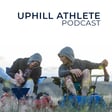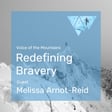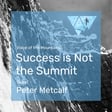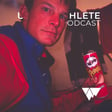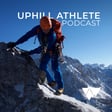Introduction to Uphill Athlete Podcast
00:00:00
Speaker
Welcome to the uphill athlete podcast, where our mission is to elevate and inspire all mountain athletes through education and celebration. My name is Steve House, and I will be your host today, along with Alisa Clark.
Featuring Pete Dickinson
00:00:19
Speaker
We are continuing our mountaineering series with a special guest from our staff who specializes in helping athletes stay healthy and injury free.
00:00:28
Speaker
We're pleased to welcome Pete Dickinson onto the podcast. Pete is a licensed physical therapist and has a board certified specialization in sport. He has served as a physical therapist for the US ski team and is an avid athlete himself.
Prehab in Mountaineering Training
00:00:41
Speaker
He's here today to discuss prehab for training and to make sure you are ready to begin your Mountaineering training. Thanks for joining us today, Pete.
00:00:49
Speaker
Thanks, Steve and Lissa. It's great to be here. Mountain athletes have been a big part of my practice since the very beginning. I really enjoy working with clients that have high demands placed on them and then have big goals. And of course, it doesn't have to be a
00:01:11
Speaker
elite gold medalists that has high demands on them and big goals. It can be just us common participants out there that are trying to get out in the mountains but need some help.
Balancing Training with Life Demands
00:01:27
Speaker
agreed and I think actually our athletes create a unique situation because a lot of them actually have very high work demands. And so it's figuring out how to balance that training with the work demands that they have as well as the travel. I know a lot of my clients are very busy people.
00:01:46
Speaker
But we are really excited to have you today, Pete, and excited to hear about the role of physical therapy in training, because I think that we tend to think of it as more of a reactive part of our training. And so I'd like to hear how perhaps we can change that mindset into thinking of it as more active.
Pete's Professional Journey
00:02:07
Speaker
But first, though, I'd love to hear a little bit more about your background and how you became
00:02:13
Speaker
became involved in physical therapy and also working directly with the US ski team.
00:02:19
Speaker
Well, it's a journey like many of us. I actually came out of college with a degree in psychology, but then I quickly moved west as quick as I could and worked for some outdoor education programs for people with disabilities. And so it's kind of adaptive, outdoor ed. So we had both summer and winter programming. And through that, I became
00:02:45
Speaker
interested in physical therapy. He was riding a chairlift with a buddy and asked him what he did. He said pre-physical therapy and it sounded like a good fit for me. And then prior to that I had been with Knowles teaching with them for a little bit so just love the outdoors and yeah it's been a great fit for me. And then for the team stuff I started working in Park City, had a practice there
00:03:12
Speaker
And that was where the US ski team is headquartered and started treating their athletes in the clinic, then was asked to start traveling with the team. So my first team in the 90s was with the men's downhill team. And then I subsequently moved to Winthrop, Washington, which has a big cross country
00:03:36
Speaker
Focus and started traveling with the US cross
US Ski Team Experience and Skiing Types
00:03:39
Speaker
-country team. It's kind of like the difference between NASCAR and Formula One You know, the downhillers are getting banged up all the time big surgeries high demands, but then the the endurance crowd with cross-country It's it's more like tuning a Ferrari
00:03:57
Speaker
Matt would come used to characterize it. It's more subtle work, more focused on recovery, and that's really helped me broaden my background in treating the high-demand individual.
00:04:14
Speaker
Well, that's how we first met, Pete. I remember walking into your clinic in Winthrop, Washington, probably back around 1997 or 98 or 99, somewhere in there when you probably weren't even open yet.
00:04:28
Speaker
And I was a 20-something year old climber with a pretty serious injury that had resulted from a crevasse ball where I had basically torn most of my hamstring off of one of its attachment points in the back. And you helped to nurse me through that. I was quite some time ago. So it's nice to still be working together, albeit in, let's say, more positive ways now.
00:04:55
Speaker
Yeah, no, you were a little bit of a train wreck back then. That was for sure not subtle therapy back then. Yeah, that was not subtle therapy. So let's go back to sort of the focus of this episode is we want to talk about prehab specifically.
Readiness for Structured Training
00:05:18
Speaker
What does that mean to a physical therapist and how does an athlete know? How would an athlete know if they're ready to begin a structured training program, whether that's in a training group or with a coach or from a training plan? How does one know?
00:05:34
Speaker
Yeah, that's a hard thing because we all come to these things with our previous injuries or activity background. And where does that place us on the continuum of being ready to take on a structured plan? And how do we know that?
00:05:52
Speaker
And so when I look at prehab, getting ready for an activity, I think about having a great strength background because strength is, is really essential for all these activities. And maybe we'll talk about durability a little bit later. But having a good enough
00:06:13
Speaker
strength basis in which we can tolerate all of our aerobic activity without developing all the tendonitis and tweaks. So that's a good starting point. Can I perform without getting injured or can my current condition with my injury history or whatever I have right now, will that allow for
00:06:40
Speaker
further training, but it's all about this continuum and everyone's individual about that. And that's what I love, having a coach help determine that. And then we, I know at Pill Athlete, we have a team of people to come in and provide additional insight with the nutritionist, physical therapy, you know, and the teams that I work with, we have a staff attending to these athletes.
00:07:10
Speaker
When we're out there and we're not in a team setting, we don't have that anymore. And so that's why I like having a setup where you can get coaching, you can get physical therapy, nutrition, all these other services.
00:07:23
Speaker
I think that that's kind of the basis of all of this is that every athlete is an individual. And so that's part of the challenge of making these podcasts as part of the challenge of more group training. But if we were to say separate athletes into two categories, we'll say category one is coming off of a more prolonged break. So say
00:07:47
Speaker
three plus months. I know some people we get it can be I haven't really been consistent for five years I've worked at a desk job versus an athlete who took a bit of downtime in between seasons, but still has a strong base. So say an athlete who maybe took two or three weeks off just as a rest season.
00:08:07
Speaker
How do you treat them differently and what are you looking for in these athletes as say you are assessing them for readiness to get back into things?
Importance of Gradual Training Increments
00:08:19
Speaker
Well, the easy one is just coming off a short season or an off season, getting ready to get back to your focused goal-oriented activity or project that you have coming on, that you've taken on. So with that, typically you're pretty good with your aerobic activity. You've been active, but you haven't maybe been as focused about your strength activity. So that'd be returning to lifting heavy things
00:08:46
Speaker
and getting your strength basis elevated so that as you then start increasing the volume of your aerobic activity and the intensity and then adding terrain that you can do that gradually. Now for all groups we have this rule.
00:09:04
Speaker
Pretty much ten percent rule and the ten percent rule is that you are bodies are amazing we have this ten percent ability to overreach to increase our volume intensity load whatever by ten percent and we can adapt in fact it's a stimulus for adaptation but
00:09:24
Speaker
If we double it or triple what we are normally used to doing, then that increases our ability to, or the chance of reacting and getting injured. So tying into what your increases are is really important wherever you are on that continuum. So you don't, you know,
00:09:48
Speaker
Suffer from oh, yes, which is our over enthusiasm syndrome, which we are all guilty of doing And that's how we get into trouble because we get so excited It is so fun to be out outdoors to be hiking up getting up that hill love put a hill in front of me I just love that but that makes it up easy to overreaching and cause a problem and
Strategies for New or Returning Athletes
00:10:16
Speaker
For someone that is coming newer into an activity or with a long layoff, then a lot more care and attention is how do we increase minutes of activity? And we try and narrow down these other extraneous factors with terrain, try and get easier with terrain and just increasing minutes of activity. And then layering in, so you're layering in volume first, and then you'll start sprinkling in some intensity.
00:10:46
Speaker
maybe adding in terrain because we want to get folks uphill. Then just build the strength, build the strength, build the strength. Strength makes everything good. One of the things that I'm hearing so far, a theme I'm picking up on both of your responses so far is that
00:11:09
Speaker
the athlete kind of knows themselves, right? Like whether it's somebody returning from an injury or whether somebody is trying to assess themselves for prehab, they kind of have a sense of themselves already. They know, you know, I know what injuries I have sustained over my career, right? You don't necessarily know that I'm meeting me for the first time, but I know and I'm going to come in, I'm going to, you know, you're my PT, I'm going to tell you about someone that I'm going to give you my history and so on.
00:11:37
Speaker
And so this kind of leads me into my next question, you know, how can an athlete assess on their own, whether or not they're ready to start training in a healthy way? I mean, Elisa talked about these two kind of use cases of like a really long layoff or a planned layoff, but is there some sort of like,
00:11:57
Speaker
the yardstick. I mean, I know my body. I know what injuries. You say I need to be strong and strength. How did you say it? Strength takes care of everything. But how do I know I'm strong enough? And what about alignment? I mean, these are the things like what am I over strong in one area? Am I underdeveloped in another? Like how do I figure that
Self-assessment and Goal Orientation
00:12:19
Speaker
out? How do I approach that problem?
00:12:23
Speaker
Yeah, that's a great question. Of course the most important thing is to know yourself.
00:12:32
Speaker
And knowing yourself means to be able to interpret the stories we have in our head that are pushing us to do things maybe we shouldn't do. And so taking care of that side of the coin. Because you can really get in your own way a lot. If you're not listening to how your body is responding, because you're so goal-oriented that you're just going to push ahead regardless.
00:12:56
Speaker
So you have to be careful of that quality and that characteristic. We love that goal orientation. That push is required at times. But in the preparation training process, it can often get in the way. Things that we look at on readiness is function, how you're able to do things.
00:13:20
Speaker
How are you able to hike, to go uphill, to go downhill, handle varying terrain? And then how you adapt to that, how much of that volume or that activity, how much fatigue does that cause? Are you able to do that on repeat days? So some of these self-assessments are important for your readiness to take on activities.
00:13:45
Speaker
And then again, knowing what you're doing now, extrapolating out a little bit more, okay, can I get started doing this? That 10% rule can come in handy with that. So knowing what you're doing currently.
00:14:02
Speaker
And just like any marathon training, we've got this goal out there, but we're here. So we've got to draw a line to get up to there and we're adaptive. So you can just start chipping away at it from wherever you're at. You can achieve, as you know, Steve, any goal that you set as long as you are cognizant of how much time that's going to take and the support that you need.
00:14:31
Speaker
uh, for that, uh, steps that you take along the way, right? Like not taking too big of a chunk. That's right. So I'm hearing mistakes made when you got this big goal, but you have a really limited and you're at your preparation is at a low level and you don't have a time to allow your body to adapt. Then you're really going to overreach and, um, uh, get into issues with that.
00:14:57
Speaker
Our body's an adaptive organism. It's a biological process, though, and that takes time. Time is your friend.
00:15:04
Speaker
time is your friend, strength is your friend. These are themes that are coming to the surface. You got a lot of friends out there, coaches, support and staff, your community is, is huge in this. Because there's a lot of knowledge out there. You haven't, trust me, you haven't made all the mistakes. You may have made most of the mistakes, but there are other mistakes out there that you haven't made that
00:15:27
Speaker
you can learn those lessons from other people. And then just to support, we love, we don't want this to be an individual process. My team members will all report.
00:15:40
Speaker
that being an in elite sport is a isolating selfish activity at times. And they're not selfish people, but their activity kind of forces them to pigeonhole themselves into who they can meet, what they can do, their social life, uphill athlete. I know that well and in that term years.
00:16:07
Speaker
Yep. So tapping in the community can be hugely supportive and beneficial. I think that's actually the sign of someone
00:16:19
Speaker
who is trending towards success or has found success at a high level is that they have a team around them. Granted, Steve is a much higher athlete than I am at this point. But one of the things that I've noticed in my own athletic pursuits is that as I built a team up, the better that I do because I know who to go to when
00:16:46
Speaker
I'm having trouble. And the other point that I think has come up a few times and Steve brought this up in the last episode is the narrative that you tell yourself.
00:16:57
Speaker
And so I think that one of the things that we struggle with is, is that narrative accurate to where you are?
Role of External Feedback in Training
00:17:07
Speaker
And I think sometimes it's very easy to tell a story that might not be completely true because either you really want it to be that way or you're protecting yourself from the vulnerability of what that story could reveal. And so I think it's really helpful to have a team that helps you to
00:17:26
Speaker
question that narrative to make sure you're on the right track of like, maybe I'm not ready for this yet. So it's funny that that that kind of internal narrative has come up the story that we tell ourselves about ourselves. Well, I, you know, I've spoken to 1000s of athletes the last seven years of uphill athletes existence and that have come to us for coaching or training groups or whatnot. And
00:17:52
Speaker
The ones that have the most unrealistic plans, as I think back, are often the ones that were the most isolated. They'd never, in many cases, done the sport. Like, I want to climb Everest without supplemental oxygen three months from now. And well, how much mountaineering have you done? Well, I've never been mountaineering.
00:18:10
Speaker
It's like, oh, OK, well, OK, we got to start at the beginning here. And sometimes you can course correct with those people. And sometimes it's a conversation. Sometimes it takes years. And sometimes it takes some time to get the buy-in. But I think that this community connects back to physical therapy and prehab and knowing I'm ready, because that's probably often a great reference point as to whether or not
00:18:39
Speaker
you know, you are going to be able to start an endeavor with a structured training plan and remain injury free and continue to adapt as we should given the right timeframe, you know, our community. And that's one of the things I think is so important with Epilaphy is creating a community or a bunch of little mini communities all over the world that where people start to connect over this, over training and correcting
00:19:08
Speaker
correctly adapting to improve not only for their sports, but for their lives, and start to have these people to have these discussions with. And some of that starts right here, but I think this is really, really key.
00:19:23
Speaker
Yeah, I mean, I often see people come with maybe expectations that aren't in line with reality a little bit, but you'll also see people that they've tried, they tried on their own and they keep on getting spit out because their progressions aren't, there's some training errors being made. So that's why I love when you can have a training plan or a coach
00:19:49
Speaker
and then a support team, and then you can really reduce your training errors. And when you reduce training errors, you reduce injuries. You reduce all the Achilles tendonitis, patellar tendonitis,
00:20:07
Speaker
Um, foot issues that I hear so much about, um, uh, usually most injuries are training in that, in that regard. And then that's balanced by you get someone with big hours of training. Um, then that's a different issue because then.
00:20:26
Speaker
odd things happen when the body is under that much stress for so long a period of time, then you can see some odd things that it really helps them to have an experienced eye looking at that because they're not usual. They're going to be missed. And my bigger hour athletes are the ones that teach me the important lesson of listen to your patient because they'll tell you if you pay attention what's going on. Yeah.
00:20:54
Speaker
But those are the people that need in-person physical therapists, so. Yeah, yeah. You'll see all sorts of autoimmune stuff or just strange presenting conditions. So how should we think about physical therapy?
Proactive Physical Therapy Approach
00:21:13
Speaker
I originally thought of PT as reactive work, but should we be thinking of it as everyday active work and injury prevention?
00:21:24
Speaker
What does that look like and what can we do to help our athletes take on this more active, preventative point of view of physical therapy? Right, well, yeah, let's see. Prehab isn't just under physical therapy. It's strength and conditioning, coaching. We all have our finger in that pot of getting someone ready.
00:21:56
Speaker
for the imposed demands that are coming. And when you need physical therapy is when you have a loss of function, loss of range of motion, you have acute injury or you have a chronic injury you haven't been able to overcome. Those are good conditions for a physical therapist to put their eyes on you.
00:22:18
Speaker
and to give some insight into some directions you should be going that would be maybe counter to the stock. Okay, I just wanted to do deadlifts, I wanted to do overhead presses, pull-ups, things like that. Because we're all individual and we all will benefit from an individualized approach.
00:22:42
Speaker
So the other part of that though is I like being involved on the prehab throughout the whole process because we like little tweaks and little injuries not to become big things. And that's kind of the team concept why you have someone kind of involved is that
00:23:00
Speaker
You don't want to let things develop because you're just ignoring it. So you want to treat little injuries so they don't become big injuries, and then you don't lose training time. And that's, you know, that preparation period of time where we're trying to continue to increase, increase, increase volume or intensity and prepare for that big event. We don't want our big,
00:23:27
Speaker
The big thing that gets in the way is we lose time due to injury. We don't want to sacrifice that. Yeah. Yeah. And I think that goes back to truly the, the secret of athletic performance and trading is consistency. And so if you lose that time, you are losing that consistency.
00:23:50
Speaker
Um, but I mean, so on a more positive note, I would be curious. I know it's, yeah, I feel like sometimes with physical therapy, I'm sure you feel this at times it can, it's like you're, you're the doctor of, you're seeing people when they're perhaps not at their best, they're coming in injured or tired, you know, things just haven't been going well. But to flip that script a little bit.
Traits of Durable Athletes
00:24:16
Speaker
What commonalities do you see with athletes who have built, and I love this word, durability? So athletes that are doing things right, that are able to keep that consistency and stay healthy. So durability, that really speaks to someone that has
00:24:38
Speaker
Uh, greater training hours, they're active consistently, uh, throughout their week, um, throughout their month and throughout their years. And they have years background of being very active, uh, being exposed to a lot of load typically. So either, uh, self-imposed through strength training or through their work conditions. Um, and.
00:25:05
Speaker
They have good learning behaviors. They learn from their mistakes so they can keep in the game. You don't accumulate hours over many years if you get spit out. So usually you have to have good learning behaviors, keep your injuries manageable, early treatment.
00:25:26
Speaker
is important. They also know how to manage fatigue. They're comfortable with fatigue. Their durability usually speaks to someone that's very motivated, so they don't mind accumulating fatigue, but then they recover. Fatigue is an important part of athletic preparation. You have to expose yourself to that so that you can adapt to it.
00:25:48
Speaker
And so those are some of the characteristics of someone that's durable. They've been in the game a long time. They've handled load for a long time, but they have pretty good behaviors. Yeah, I've often thought about this with climbers that I've known, where there are some that are, as you say, durable, and there's others that just seem to be constantly
00:26:15
Speaker
injured. I think there's sometimes just a certain genetic component, sometimes my conclusion. Um, some people have shoulders that are just never going to stay stable. And one of the things that I've noticed is with the people, you know, and I've learned just the hard way multiple times is taking those injuries and learning from them, uh, you know,
00:26:43
Speaker
One example for myself is with a shoulder issue that I developed when I was ice climbing a lot and then learning through research and physical therapy and talking to my community that I was weak in a certain way. And then ever since then, there's been a TheraBand hanging on a door knob somewhere in every house I've lived in. And I don't count reps or sets or any of that.
00:27:13
Speaker
I do my certain little exercises and I just kind of sort of second nature. It doesn't really take any time. It doesn't take any energy, but it does keep my shoulders healthy. And I haven't had shoulder issues in over a decade because of adapting that behavior. And I think that that's the kind of thing that is a small thing, but can be really, really helpful.
00:27:36
Speaker
We're all individuals. We all have our special things. And Steve, what you speak to, you identifying that, and it's different for everyone. For me, it's my spine. For Alyssa, it's nothing because she can do 95 marathons in 95 days. But for the rest of us, yeah, we have our,
00:28:02
Speaker
you know, Achilles heel, we have something that we have to keep up on. And identifying that knowing yourself really goes a long way towards keeping you in the game, not losing training time. Well, I want to unpack this for a second, because I'm curious, like, you know, at least to tell us a little bit just about your 95 marathons and 95 days.
Alisa's Marathon Experience
00:28:24
Speaker
I admit that I don't know that much about it. When was it? Like, what were they? Like, what was the whole idea? And then I want to
00:28:31
Speaker
Pete to figure out why you didn't get injured doing that. That is a, yeah, that this is a fun kind of real life case scenario. So I, well, I
00:28:46
Speaker
Okay, I won't add that part because we'll have Pete unpack it. But I began them in March of 2020, when we lived over in Italy, COVID lockdown was very bad over there. And I had a treadmill available to me, but we were not allowed to go outside. All my races were canceled for the season. And so I
00:29:09
Speaker
was trying to keep myself, honestly, from going insane because I am used to a high load of trading. And so I found myself just kind of mindlessly running up and down stairs in our house. And I was like, I have to do something that gives me a goal and focus. And so I originally planned to run a marathon every day until restrictions were lifted that we were allowed to go outside. So it's supposed to be 14 days to start.
00:29:38
Speaker
And then it quickly became something that just didn't go away. So I continued to run for 95 days and that included an international move from Italy to Florida. So I ran on a German air force base in the middle of the night. I ran in
00:30:02
Speaker
three different states, and it was just kind of a wild journey that I never anticipated doing. It just kind of fell in my lap, we shall say. Wait, wait, wait. So you ran 95 marathons on a treadmill? I probably ran 50 to 60 of them on a treadmill because we were not allowed to go outside. That's still incredible. Wow.
00:30:33
Speaker
And so to be clear, you came with a good training background for this, because I know you're a former skier and bi-athlete and have been exposed to, you were also a soccer player or? Lacrosse, but also soccer. Yeah, and all those activities. That's a great, wonderful preparation for anything in life.
00:30:57
Speaker
Uh, we should all be so lucky to have that. Um, uh, so I'm curious, did you do any maintenance activities, uh, during, uh, during your 95 marathons? So probably the best maintenance was a good diet and sleep that, that is truly what sleep was is the magic elixir. If I did not sleep well, the marathon the next day was very hard. If I slept well.
00:31:26
Speaker
then the marathon was a lot easier. And so cumulative fatigue, managing that, um, by sleep, I mean, you wake up and you're like, okay, I'm ready to go. Um, I did not, I think I stretched just a little bit, but honestly, it was more about energy conservation than pretty much anything else. Yeah. Doing the big things first.
00:31:53
Speaker
you know, sleep and nutrition, um, and probably also managing your pace and your, your, um, your train was really super consistent. So your, your, we have a principle called the said principle, the specific adaptation to the imposed demands. And after a while, your body has adapted to doing that running. And you started off though, without, with it being not much of a reach because you're
00:32:22
Speaker
probably fit and had a good strength basis to protect your joints. If you're not strong enough going into it, your joints will see too much load. Your tendons will see too much load because they're not stiff enough for that activity and you'll get into trouble for that. So it probably helped you that you had a treadmill actually for a lot of it as long as you're okay between the ears being on a treadmill for 60 marathons.
00:32:58
Speaker
I'm not even going to touch that. So the thing we see with activity, though, it causes inflammation in your tissues. And with that, with training, with anything, you get your fibers get a little sticky. They form bonds between each other in the fashion. You don't slide and glide. Then that starts skewing off the vectors for all the force loads on your foot and your kneecap and shoulder.
00:33:08
Speaker
I think a lot of people would question if I'm okay between the years, but I think that's what makes me lovable.
00:33:29
Speaker
So I was curious as to whether you're a pretty flexible person to begin with. I am not. I am not very flexible. I will say, oh, there was about three things I was going to say I noticed. Now I'm drawing a blank at what I was going to say. Oh, okay, here we go. Number one.
00:33:56
Speaker
I probably put on 10 pounds in the first 20 marathons because of inflammation. So that was something that makes exact sense to what you were just saying, that the inflammation added quite a bit of water weight. It did come off.
00:34:19
Speaker
My upper body then shrank to nothing basically. And my quads were very strong. Um, my legs probably gained quite a lot of muscle. The other adaptations were that I could run a, I could run four marathons in a row within a minute of each other pacing wise. I had an exact pace that was exactly where my body was efficient. And I did not have to try at all to hit that pace. It was.
00:34:49
Speaker
like a metronome. And what's interesting is that my coach
00:34:56
Speaker
uh, was actually going to have me come down from the marathons. Um, I ended up getting sick, so wasn't able to finish them hence 95, not a hundred. Um, but he was going to actually have me decline the mileage. So not just stop cold Turkey, because I had created such an adaptation to running the marathons. He felt that I would actually cause more damage if I just stopped rather than if I ramped down to say 20 miles, 16, 10, then rest day.
00:35:27
Speaker
And that's the part of having a coach help give you some guidance during these high demand episodes. Yeah, no, it's fascinating story. Just love that. And we've got a lot of athletes out there with a lot of different stories like that. I still have one question though, because I'm sure there are listeners in the car where Pete, you said, well, you played soccer and lacrosse, so that set you up like
00:35:54
Speaker
I mean, we all played soccer and lacrosse. I mean, I didn't play lacrosse, but you know, we all did something like that when we were kids. Why, why that? Like, why did you hone in on that? Like what, like, yeah, so she skied and I mean, yeah, me too, but I could not have run 95 marathons in 95 days at any point in my life. So, so what are you getting at in that? What are you trying to say with, with that exactly?
00:36:18
Speaker
Well, first off, Steve, if you grew up in East Central Illinois, no, you don't have access to soccer or lacrosse. Back in the day, it was only football, basketball, and baseball. Yeah, in full disclosure, I also had no access to soccer or lacrosse. I had cross country running or football in this ball.
00:36:39
Speaker
Okay, so in response to why some of these other activities are so good, change of direction explosively with soccer and cross or other sports. Early on, especially, develops ourselves physically and you get really able to tolerate eccentric load and change of direction.
00:37:05
Speaker
which I think relates really well to descending and ascending mountains and handling varying terrain. And when you expose yourself to that early through your childhood, I think that sets you up to expand on that later than when you just have a unilateral, no change, no high loads early on, you have to work a lot harder to develop that.
00:37:34
Speaker
later in life. That's why we want our kids playing all sports, defining out what floats their boat and see if you can sneak in some strength training as well so they understand how to pick up heavy things because that's also a very useful preparation tool for high demand activity.
00:38:03
Speaker
I also grew up running and hiking on technical trails, which I've kind of been told over the years that that small muscle strength and balance capability also coming from Nordic ski training does help kind of long term. And so I think that I've just was lucky enough to
00:38:25
Speaker
have all of those factors come together. And I'm saying this right before I go race 100 miles this weekend, and I'm probably gonna get blown up by an injury after this whole conversation. Well, yeah. No, I think you'll probably be pretty prepared. I'll be curious as to whether, but you returned back to your strength activities and regained, because you didn't have the ability to do that for many months. You were just running.
00:38:55
Speaker
So did you notice any difficulty transitioning to other activities after your 95 marathon days?
00:39:04
Speaker
Um, I certainly lost a tremendous amount of upper body strength. I mean, I truly, if you look at the body's ability to adapt, it adapted to the fact that I did not need upper body strength at all to perform what I was asking it to perform. So that took a while to build back up. And I did focus on strength following the marathons more than I usually do.
00:39:33
Speaker
So yeah, it's fascinating how our body transforms with different types of training and over a period of time as well. So that should be very encouraging to anyone listening that they can make the changes. And we want you to make those changes.
00:39:54
Speaker
with as little drama as possible and without making those training errors that we've all made due to our over-enthusiasm syndrome and knuckleheadedness. And this is also something that I would say, we're going a little bit off of topic, but it's a little bit fun too, with people who do a lot of different sports as an adult where they want to do it all.
00:40:21
Speaker
they're often frustrated because they are plateaued. And the reason they're plateaued is because their body doesn't quite know what adaptations to keep and which to get rid of. I know that when I was only high altitude mountaineering, my body looked in a certain way. And when I was in a period where I was doing more tactical rock and ice climbing, my body was very different. But during those periods, I was focused on those activities and those
00:40:50
Speaker
when I was high altitude mountaineering his legs and lungs. And when I was in tactical climbing, well, it was a lot of upper body and a lot of arm strength and finger, you know, fingers to elbows. And your body looks a different way, but you do do adapt. And I was focusing on those things and not trying to do it both at the same time. It's very difficult to try to do multiple sports with different, different demands at the same time.
00:41:18
Speaker
And I often tell people, if you want to improve as an athlete, pick one thing. You can do three different sports, but you're only going to maintain at those three sports. If you want to improve as a runner, let's pick running and build you up and improve your running for a period of time. And then you can go back to doing those three sports. And you can probably keep that running at a higher level for a long period of time and perhaps work on something else.
00:41:46
Speaker
elevate multiple capacities at the same time, it's too much. Yeah, you we have a saying, you get good at what you do. So that's where you want to have the focus you want we in in sport training, we talk about general preparation phases, and then specific training, which really sharpened you up for that activity. And you have to be going from general to more specific. I know in our
00:42:14
Speaker
U.S. cross-country team, there's a lot of very specific cross-country skiing and then strength twice a week. So it's kind of, even in a hyper-focused endurance sport, they also don't like to lose the strength support for all those specific activities. And I think that's mimicking in many, many, many, many events.
00:42:42
Speaker
And that's what we do with our training plans. It's what we do with our athletes is that base period of more generalized fitness in aerobic and strength training. And then as you're getting close to the event, it gets more specialized for sure. Um, so glad to hear we're kind of tracking on all levels, but same thing.
00:43:05
Speaker
If there were two to three exercises, and maybe this is an unfair question, but if, if you could have an athlete do two to three exercises every day that would potentially reduce the risk of injury, what would they be?
Injury Prevention Exercises
00:43:20
Speaker
Oh, I love this question. This is great. Um, okay. Number one, for strength and mobility to do one exercise, uh, one to rule them all.
00:43:34
Speaker
would be a floor to stand get up, and for Turkish get up. And for those that don't know this, what you do is you lie down on your back, you press up a heavy kettlebell, and then you go from straight on your back, there's some dance moves, basically, to go up onto your elbow, to go up onto your knees, and then to stand up with that weight overhead, and then to reverse it.
00:44:03
Speaker
Now, the interesting thing about that activity is it requires immense core strength and stability. It also helps with a lot of mobility, especially through your thoracic spine, which many of us lack.
00:44:18
Speaker
Um, so it's good for the back, good for the upper back, the thoracic spine. Um, and it's, uh, a big strength movement, both for your shoulders and your legs. So if there's one activity to incorporate on a regular basis, it would be a, uh, Turkish get up. Number, number two. I absolutely love hate on Turkish get up. Yeah. Oh, well you did ask for the easy ones. Right. So it was just one pick, pick the.
00:44:47
Speaker
hard one that would really help actually with your durability to going from Florida standing and picking up a heavy weight that really stiffens you up. And the strength game is a tension game. So we like learning how to be stiff and control heavy load. The second one, maybe going in a different direction is with all of our other activities, we create these localized inflammation from micro trauma or for just
00:45:16
Speaker
working hard in our tissues. And so to release those bonds, those bonds are temperature dependent. So if you just create some friction, they release and they start sliding, gliding better, and you reduce some of the negatives of chronic training. And that's just going on a foam roll and rolling out your legs and your hips and your back.
00:45:39
Speaker
in your arms. It can be just with a simple three foot foam roll. And so we really like that for loosening up your whole fascial system to take away some of the negatives of chronic and heavy training. And then
00:45:58
Speaker
Uh, number three also speaks to recovery and with a lot of training and a lot of activity where we have our sympathetic nervous system is stimulated. And if that keeps going all the time, you don't recover from the training. Um, and so you're not getting the benefit from that. So we like doing things that, that activate our parasympathetic nervous system. And that's who the Vegas nerve, they will nerve. And one of the.
00:46:27
Speaker
There's two things that really help that is foam rolling that stimulates the baroreceptors in your deep in your tissues, which activate your parasympathetic nervous system. So foam rolling is nice. And then the other thing is deep, slow nasal breathing. So doing like a two or three second inhale and a six second exhale through your nose. We think now that there's some theories that
00:46:57
Speaker
With all of our meditative yoga, all these other restorative activities, one thing they have in common is deep nasal, slow nasal breathing. And so I encourage you to incorporate something with that. It helps with stress, helps with a lot of things. So those were the three things. Pick up something heavy and go overhead. Roll out your tissues and deep, slow nasal breathing. Those are three really good ones.
00:47:28
Speaker
So I think that that kind of leads me into thinking about recovery again, particularly mentioned the foam roller. We talk about foam rolling a lot. How should an athlete differentiate between delayed onset muscle soreness from training or a potential injury that's coming on?
00:47:58
Speaker
Sarah, how do you talk about that with patients and athletes? What are the cues that they should be looking for, that we should be looking for? Yeah, and we talk about treating injuries at a low level so they don't become big. So it gets a little bit harder when I tweet that a little bit. Is that really something or not? We look at
00:48:22
Speaker
If you have a loss of function, your ability to do something, be able to pick something up, put that plate in that upper cabinet, do something you're used to doing. Is that now getting difficult to do or painful?
00:48:41
Speaker
a loss of range of motion if you're getting stiffness or you can't move overhead or do a deep squat, things of that nature. Or you're getting some gait impairment. You're starting to have a hitch in your gait when you're running or hiking uphill or walking. So those start concerning me more if you're ticking those boxes. Of course, you need swelling or deformities.
00:49:11
Speaker
But your training history also will help guide this. If you've just done a heavy strength session, then getting some muscle soreness, some DOMS from that would be expected. And I would give you a few days to make sure that that should clear within 48 hours.
00:49:35
Speaker
and you can move on from that. But if something is lingering, and I give it a pretty short leash, one to two weeks, then we want to start addressing it right away and not let things go on for longer than that. Because then we start losing training time. We usually do very quickly with some mobility, some kinesiotes, some supportive strapping, some other techniques we have to mobilize tissues, loosen things up.
00:50:06
Speaker
look back over training history, making sure we don't have a training error and to correct that. Of course, coaching is so important with all that. And again, I'll just reiterate with a coach or a plan, you really reduce your risk of injury because you're not making training errors. That's the foundation for all this usually. That makes sense. So it sounds like, I mean, a lot of it is knowing yourself to know when things are different than they usually are.
00:50:37
Speaker
which takes training history. Sorry, that's a funny way to put it, but essentially being able to know your training history to know, okay, that's usually an easy exercise. Something's different about it. Here's a red flag. Right. But you're a knowledge base for an athlete rhizona continuum. Yes, some people, they're very
00:51:01
Speaker
that have made a lot of mistakes. They have a lot of experience. And so they can tap into that. Then you get those that are just starting off. And they kind of don't know, is it bad? Is it good? And so that's where having at least starting with a training plan and then we can adapt from there can be really, really helpful. Because built into that training plan is discrete progressions that aren't too big. So that's what I like about that. Excellent.
00:51:32
Speaker
Well, I think that that just about wraps it up for us. This has been fantastic to hear all of your insight, Pete, and all the great stories. Is there anything else either of you would like to touch on? I would just like to quickly ask Pete because I know that he performs online assessments.
00:51:54
Speaker
of some of our athletes that come in that have injuries that are often working with a coach. And Pete, how does that work? How does that look for people? How do you do that? Well, if you've identified with yourself that you need some help, that you've struggled before, or you have an ongoing injury, that maybe you've gone through a treatment phase, but you're not quite
00:52:21
Speaker
sure how to get back to that hopping on a plan and progressing from there. Is my injury going to slow me down? Am I ready at my current status to initiate something? A lot of those can be just a consult.
00:52:43
Speaker
over Zoom or a phone. If it's more involved, then we can go ahead and transfer into a more structured approach with actual physical therapy activities. So it kind of depends on the needs of the individual. But I will speak that probably one thing to add that I think it's very powerful to have goals in your life.
00:53:09
Speaker
and to be striving for something that pushes us further than we normally would maybe organically evolve. So having strong goals, I call it fear-based training because you'll do the work because you know it's really going to hurt if you haven't done the work once you do your event. But I love hearing everyone's goals and the variety of goals within the uphill athlete system. It's remarkable.
00:53:39
Speaker
Yeah, we have a lot of great community members out there doing a lot of amazing stuff. I think the good test of a goal is if it instills a little bit of fear, not too much, but at least a little bit, it's probably a good goal to aim for. Yeah, little motivation, internal motivation is good within reason. Absolutely.
00:54:07
Speaker
Well, thank you for listening to the uphill athlete podcast. Pete, thank you so much for being here. Uh, we ask if you can rate, review, subscribe, um, on all of the major podcast platforms or pick the one that you use. That's really helpful for us to reach a bigger audience. Um, so we really appreciate you taking the time to do that. And it is not just one, but a community.
00:54:37
Speaker
Together, we are a philosophy. Thanks for listening.









